Page 380 of 440
3808-2. Steps to take in an emergency
AYGO_EE_OM99J92E
Make sure that the compressor
switch is off.
Remove the power plug from
the compressor.
Connect the power plug to the
power outlet socket. ( →P. 280)
Check the specified tire inflation
pressure.
Tire inflation pressure is specified
on the label as shown. ( →P. 416)
Start the engine. (→P. 151, 154)
9
10
11
12
13
Page 381 of 440
3818-2. Steps to take in an emergency
8
When trouble arises
AYGO_EE_OM99J92E
To inject the sealant and inflate
the tire, turn the compressor
switch on.
Inflate the tire until the specified
air pressure is reached.
The sealant will be injected
and the pressure will surge
and then gradually
decrease.
The air pressure gauge will
display the actual tire infla-
tion pressure about 1 minute
(5 minutes at low tempera-
ture) after the switch is
turned on.
Inflate to specified air pres-
sure.
• If the tire inflation pressure is still lower than the specified point after
inflation for 35 minutes with the switch on, the tire is too damaged to
be repaired. Turn the compressor switch off and contact any autho-
rized Toyota dealer or repairer, or another duly qualified and
equipped professional.
• If the tire inflation pressure exceeds the specified air pressure, let out
some air to adjust the tire inflation pressure. ( →P. 385, 416)
Turn the compressor off.
14
15
1
2
3
16
Page 383 of 440
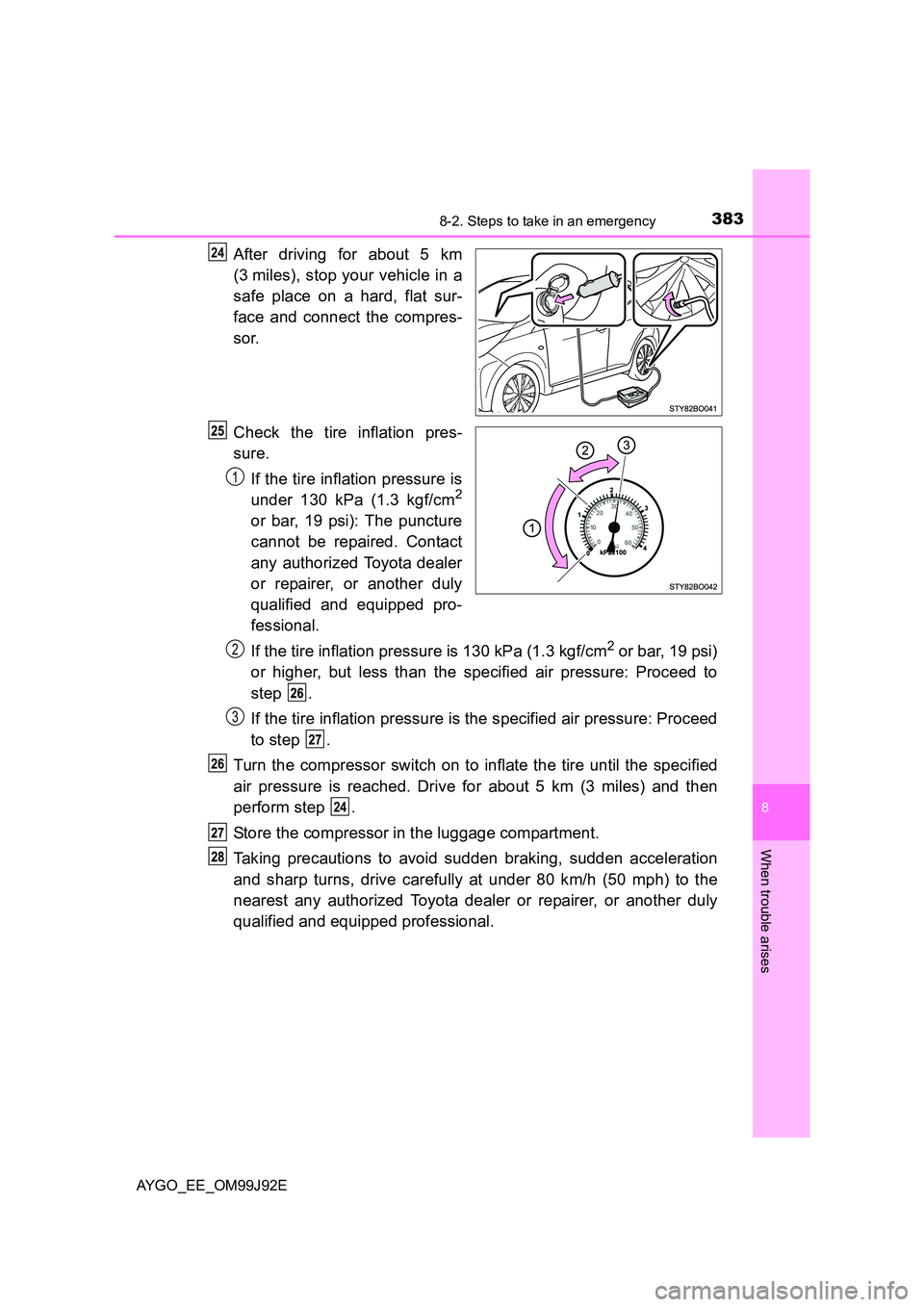
3838-2. Steps to take in an emergency
8
When trouble arises
AYGO_EE_OM99J92E
After driving for about 5 km
(3 miles), stop your vehicle in a
safe place on a hard, flat sur-
face and connect the compres-
sor.
Check the tire inflation pres-
sure.
If the tire inflation pressure is
under 130 kPa (1.3 kgf/cm2
or bar, 19 psi): The puncture
cannot be repaired. Contact
any authorized Toyota dealer
or repairer, or another duly
qualified and equipped pro-
fessional.
If the tire inflation pressure is 130 kPa (1.3 kgf/cm2 or bar, 19 psi)
or higher, but less than the specified air pressure: Proceed to
step .
If the tire inflation pressure is the specified air pressure: Proceed
to step .
Turn the compressor switch on to inflate the tire until the specified
air pressure is reached. Drive for about 5 km (3 miles) and then
perform step .
Store the compressor in the luggage compartment.
Taking precautions to avoid sudden braking, sudden acceleration
and sharp turns, drive carefully at under 80 km/h (50 mph) to the
nearest any authorized Toyota dealer or repairer, or another duly
qualified and equipped professional.
24
1
2
3
24
Page 385 of 440
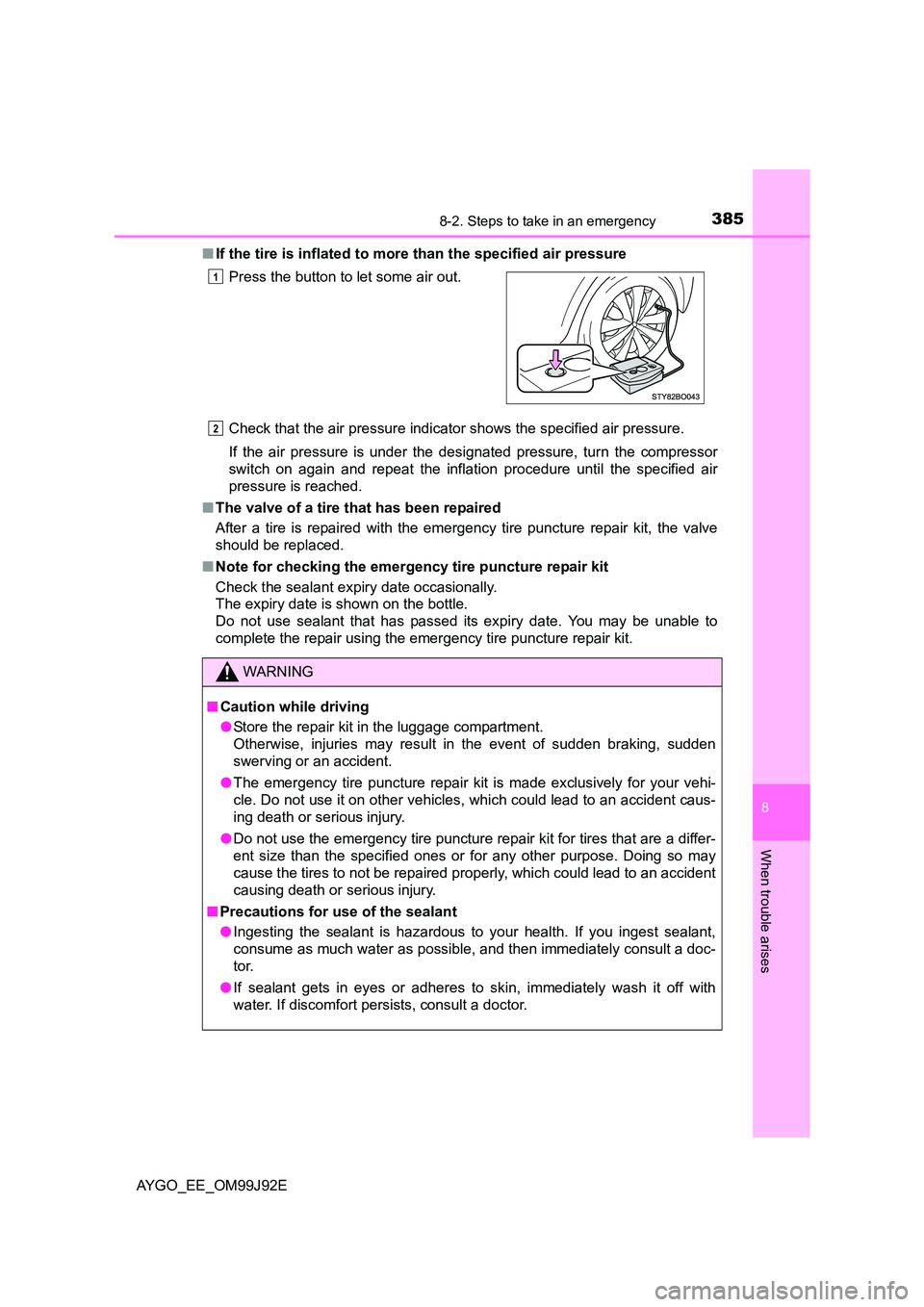
3858-2. Steps to take in an emergency
8
When trouble arises
AYGO_EE_OM99J92E
■ If the tire is inflated to more than the specified air pressure
Check that the air pressure indicator shows the specified air pressure.
If the air pressure is under the designated pressure, turn the compressor
switch on again and repeat the inflation procedure until the specified air
pressure is reached.
■ The valve of a tire that has been repaired
After a tire is repaired with the emergency tire puncture repair kit, the valve
should be replaced.
■ Note for checking the emergency tire puncture repair kit
Check the sealant expiry date occasionally.
The expiry date is shown on the bottle.
Do not use sealant that has passed its expiry date. You may be unable to
complete the repair using the emergency tire puncture repair kit.
Press the button to let some air out.
WARNING
■ Caution while driving
● Store the repair kit in the luggage compartment.
Otherwise, injuries may result in the event of sudden braking, sudden
swerving or an accident.
● The emergency tire puncture repair kit is made exclusively for your vehi-
cle. Do not use it on other vehicles, which could lead to an accident caus-
ing death or serious injury.
● Do not use the emergency tire puncture repair kit for tires that are a differ-
ent size than the specified ones or for any other purpose. Doing so may
cause the tires to not be repaired properly, which could lead to an accident
causing death or serious injury.
■ Precautions for use of the sealant
● Ingesting the sealant is hazardous to your health. If you ingest sealant,
consume as much water as possible, and then immediately consult a doc-
tor.
● If sealant gets in eyes or adheres to skin, immediately wash it off with
water. If discomfort persists, consult a doctor.
1
2
Page 386 of 440
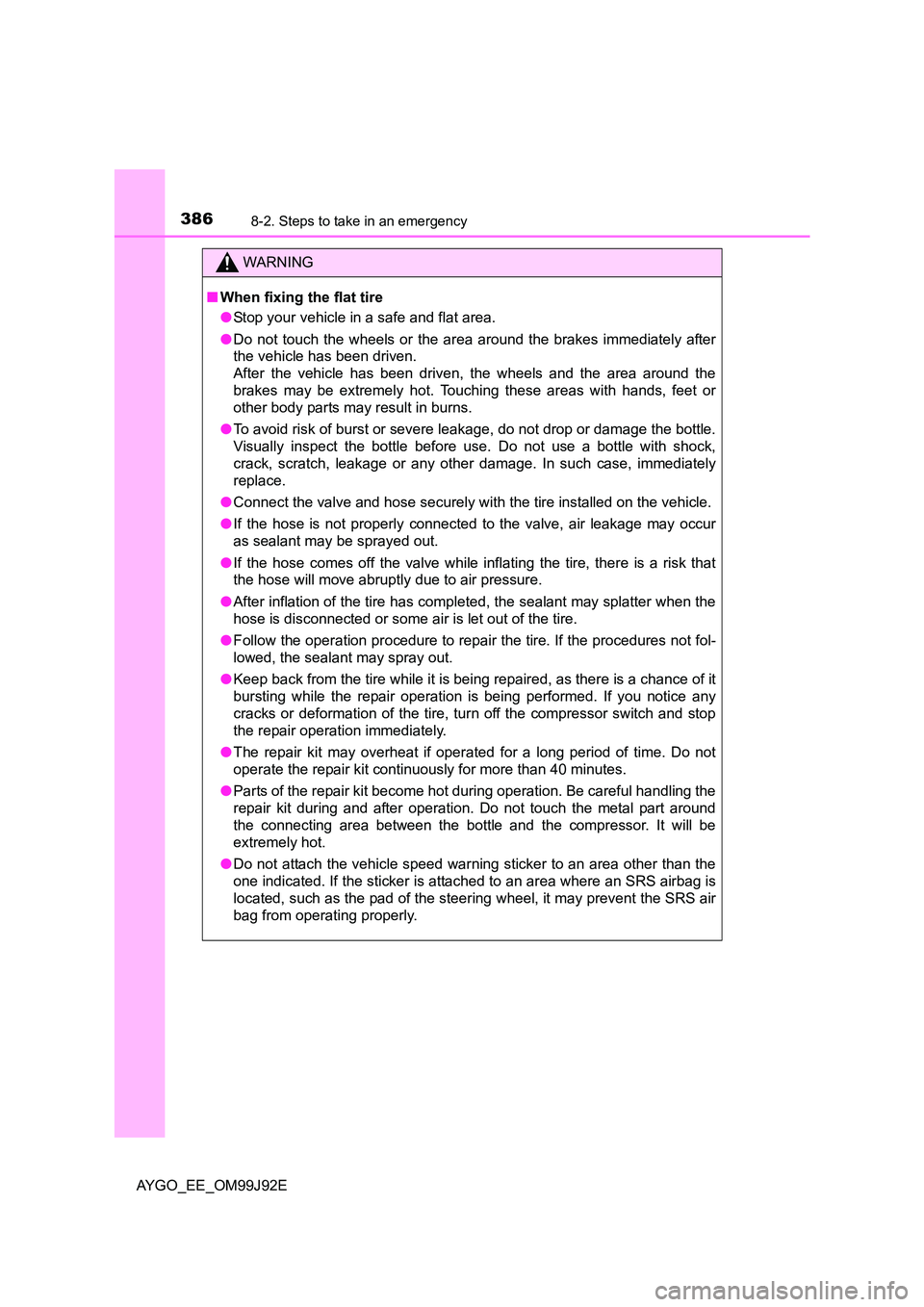
3868-2. Steps to take in an emergency
AYGO_EE_OM99J92E
WARNING
■ When fixing the flat tire
● Stop your vehicle in a safe and flat area.
● Do not touch the wheels or the area around the brakes immediately after
the vehicle has been driven.
After the vehicle has been driven, the wheels and the area around the
brakes may be extremely hot. Touching these areas with hands, feet or
other body parts may result in burns.
● To avoid risk of burst or severe leakage, do not drop or damage the bottle.
Visually inspect the bottle before use. Do not use a bottle with shock,
crack, scratch, leakage or any other damage. In such case, immediately
replace.
● Connect the valve and hose securely with the tire installed on the vehicle.
● If the hose is not properly connected to the valve, air leakage may occur
as sealant may be sprayed out.
● If the hose comes off the valve while inflating the tire, there is a risk that
the hose will move abruptly due to air pressure.
● After inflation of the tire has completed, the sealant may splatter when the
hose is disconnected or some air is let out of the tire.
● Follow the operation procedure to repair the tire. If the procedures not fol-
lowed, the sealant may spray out.
● Keep back from the tire while it is being repaired, as there is a chance of it
bursting while the repair operation is being performed. If you notice any
cracks or deformation of the tire, turn off the compressor switch and stop
the repair operation immediately.
● The repair kit may overheat if operated for a long period of time. Do not
operate the repair kit continuously for more than 40 minutes.
● Parts of the repair kit become hot during operation. Be careful handling the
repair kit during and after operation. Do not touch the metal part around
the connecting area between the bottle and the compressor. It will be
extremely hot.
● Do not attach the vehicle speed warning sticker to an area other than the
one indicated. If the sticker is attached to an area where an SRS airbag is
located, such as the pad of the steering wheel, it may prevent the SRS air
bag from operating properly.
Page 387 of 440
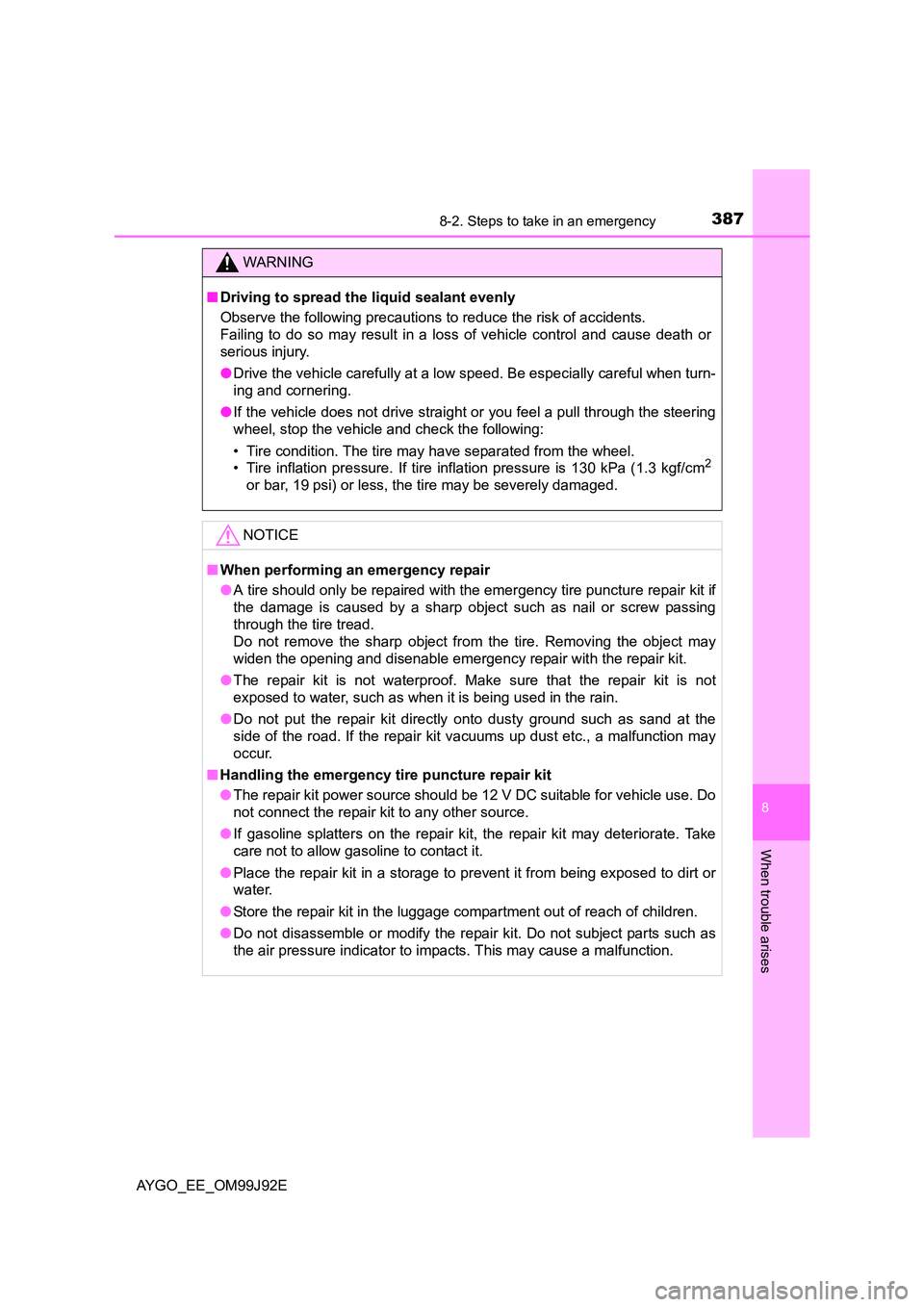
3878-2. Steps to take in an emergency
8
When trouble arises
AYGO_EE_OM99J92E
WARNING
■ Driving to spread the liquid sealant evenly
Observe the following precautions to reduce the risk of accidents.
Failing to do so may result in a loss of vehicle control and cause death or
serious injury.
● Drive the vehicle carefully at a low speed. Be especially careful when turn-
ing and cornering.
● If the vehicle does not drive straight or you feel a pull through the steering
wheel, stop the vehicle and check the following:
• Tire condition. The tire may have separated from the wheel.
• Tire inflation pressure. If tire inflation pressure is 130 kPa (1.3 kgf/cm2
or bar, 19 psi) or less, the tire may be severely damaged.
NOTICE
■ When performing an emergency repair
● A tire should only be repaired with the emergency tire puncture repair kit if
the damage is caused by a sharp object such as nail or screw passing
through the tire tread.
Do not remove the sharp object from the tire. Removing the object may
widen the opening and disenable emergency repair with the repair kit.
● The repair kit is not waterproof. Make sure that the repair kit is not
exposed to water, such as when it is being used in the rain.
● Do not put the repair kit directly onto dusty ground such as sand at the
side of the road. If the repair kit vacuums up dust etc., a malfunction may
occur.
■ Handling the emergency tire puncture repair kit
● The repair kit power source should be 12 V DC suitable for vehicle use. Do
not connect the repair kit to any other source.
● If gasoline splatters on the repair kit, the repair kit may deteriorate. Take
care not to allow gasoline to contact it.
● Place the repair kit in a storage to prevent it from being exposed to dirt or
water.
● Store the repair kit in the luggage compartment out of reach of children.
● Do not disassemble or modify the repair kit. Do not subject parts such as
the air pressure indicator to impacts. This may cause a malfunction.
Page 416 of 440
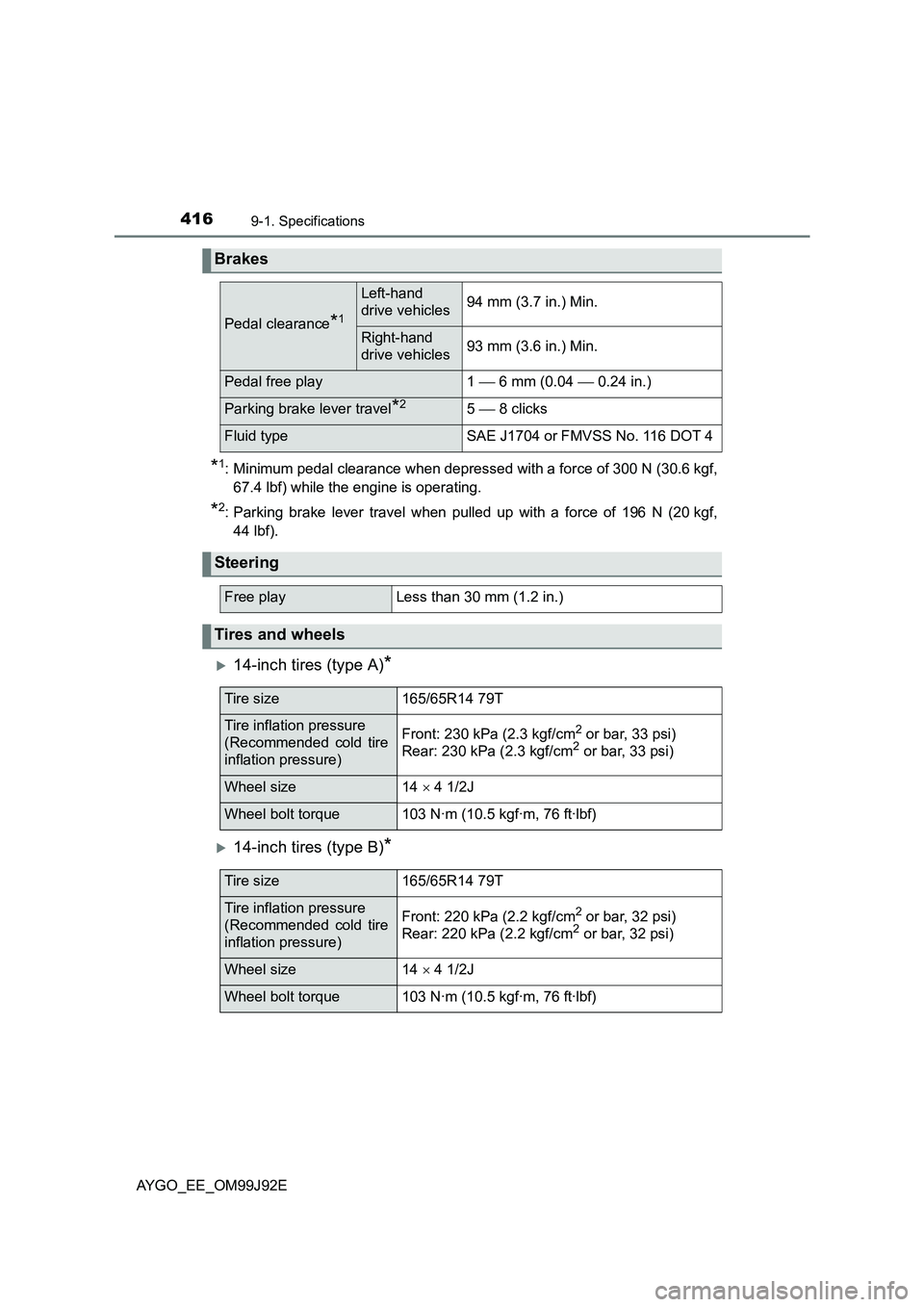
4169-1. Specifications
AYGO_EE_OM99J92E
*1: Minimum pedal clearance when depressed with a force of 300 N (30.6 kgf,
67.4 lbf) while the engine is operating.
*2: Parking brake lever travel when pulled up with a force of 196 N (20 kgf,
44 lbf).
�X14-inch tires (type A)*
�X14-inch tires (type B)*
Brakes
Pedal clearance*1
Left-hand
drive vehicles94 mm (3.7 in.) Min.
Right-hand
drive vehicles93 mm (3.6 in.) Min.
Pedal free play1 6 mm (0.04 0.24 in.)
Parking brake lever travel*25 8 clicks
Fluid typeSAE J1704 or FMVSS No. 116 DOT 4
Steering
Free playLess than 30 mm (1.2 in.)
Tires and wheels
Tire size165/65R14 79T
Tire inflation pressure
(Recommended cold tire
inflation pressure)
Front: 230 kPa (2.3 kgf/cm2 or bar, 33 psi)
Rear: 230 kPa (2.3 kgf/cm2 or bar, 33 psi)
Wheel size14 × 4 1/2J
Wheel bolt torque103 N·m (10.5 kgf·m, 76 ft·lbf)
Tire size165/65R14 79T
Tire inflation pressure
(Recommended cold tire
inflation pressure)
Front: 220 kPa (2.2 kgf/cm2 or bar, 32 psi)
Rear: 220 kPa (2.2 kgf/cm2 or bar, 32 psi)
Wheel size14 × 4 1/2J
Wheel bolt torque103 N·m (10.5 kgf·m, 76 ft·lbf)
Page 417 of 440
4179-1. Specifications
9
Vehicle specifications
AYGO_EE_OM99J92E
�X15-inch tires
�XCompact spare tires (if equipped)
*: The tire inflation pressure is indi-
cated on the left-side center pillar.
Tire size165/60R15 77H
Tire inflation pressure
(Recommended cold tire
inflation pressure)
Front: 230 kPa (2.3 kgf/cm2 or bar, 33 psi)
Rear: 230 kPa (2.3 kgf/cm2 or bar, 33 psi)
Wheel size15 × 4 1/2J
Wheel bolt torque103 N·m (10.5 kgf·m, 76 ft·lbf)
Tire sizeT125/70R15 95M, T125/70D15 95M
Tire inflation pressure
(Recommended cold tire
inflation pressure)
420 kPa (4.2 kgf/cm2 or bar, 60 psi)
Wheel size15 × 4B
Wheel bolt torque103 N·m (10.5 kgf·m, 76 ft·lbf)